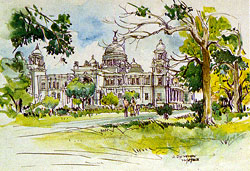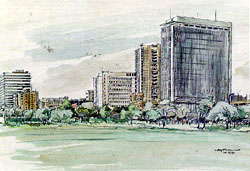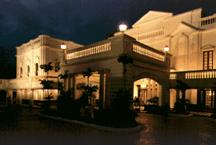| |
| WEST BENGAL: GEOGRAPHY |
West Bengal is strategically placed with three international frontiers - Bangladesh, Nepal and Bhutan. A hinge between the bulk of Indian territory and the north-east of the country, West Bengal is located at 21o31' and 27o14' North Latitude at the head of the Bay of Bengal and 86o35' and 89o53' East Longitude, with the Tropic of Cancer running through it.
The great Himalayas start a distance of only 300 miles from the Bay of Bengal and the coastal tropical rain forest, Sundarbans. |
|
HISTORY : Referred to as Vanga in the Mahabharata, this area has a long history that predates the Aryan invasions of India. It was part of the Aryan invasions of India. It was part of the Maurayan Empire in the 3rd century before being overrun by the Guptas. For three centuries around 800 AD The Pala dynasty controlled a large area based on Bengal and including parts of Orissa, Bihar and mordern Bangaladesh.
Bengal was brought under Muslim control by Qutab-ud-din, first of the sultans of Delhi, at the end of the 12th century. Following the death of Aurangzeb in 1707, Bengal an independent Muslim state.
Britain had established a trading post in Calcutta in 1698, which quickly prospered. Sensing rich pickings, Siraj-ud-daula, the Nawab of Bengal, came down from his capital at Mushirdabad and easily took Calcutta in 1756. Clive defeated him the following year at the Battle of Plassey, helped by the treachery of Siraj-ud-daula's uncle,
Mir Jafar who commanded the greater part of the nawab's army. He was rewarded by succeeding his nephew as nawab but after the battle of Buxar in 1764, the British took full control of Bengal. |
CALCUTTA :
Densely populated and polluted,Calcutta suffers from lot of drawbacks. Calcutta has been plagued by chronic labour unrest resulting in a decline of productivity capacity. Despite all these drawbacks Calcutta is city with a soul. It is the city, which is the seat of art and cultural developments. All greats like Rabidranath Tagore, Bankim chandra, Vidyasagar, Vivekananda, Satayjit Chatterjee, Kalidas were from this very Bengal. Great freedom fighters like Netaji Subhas Chandra Bose, Chittranjan, Khudiram Bose were born here. Most of the world-renowned personalities like Mother Teresa to Amartya Sen belongs to the land of Bengal. Bengal welcomes all with its charm and gracious Hospitality. |
 |
 |
HISTORY : Calcutta isn't an ancient city like Delhi, with its impressive relics of the past. In fact, it's largely a British creation, which dates only some 300 years and was the capital of British India until the beginning of this century. In 1686, the British abanonded Hooghly, their trading post 38 km up the Hooghly River from present day Calcutta, and moved downriver to three small villages-Sutanati, Govindapur and Kalikata. Calcutta takes its name from the last of the three tiny settlements. Job Charnock, An English merchant who married a Brahmin's widow whom he dissuaded to becoming a sati, was the leader of the British merchant who made the move. At first the post was not a great success and was abandonent on a number of occasions, but 1696 a fort was laid out infront of the present -day BBD Bagh (Dalhousie Square) and in 1698, Aurangzeb's grandson gave the British official the permission to occupy the villages.
Calcutta then grew steadily until 1756, when Siraj-ud-duala, the Nawab of Mushirdabad, attacked the town. Most of the British inhabitants escaped, but those captured were packed into underground cellars, where during the night, most of them suffocated in what become known as 'the black hole of Calcutta'.
Early in 1757, the British, under Clive of India, retook Calcutta and made peace with the Nawab. Later the same year, however, Siraj-ud-duala sided with the French and was defeated at the Battle of Plassey, a turning point in the British- Indian history. A much stronger fort was built in Calcutta and the town become the capital of British India.
Much of Calcutta enduring development took place between 1780 and 1820. Later in the 19th century, Bengal became an important Centre in the stuggle for Indian independence, and this was a major reason for the decision to transfer the capital to Delhi in 1911. Loss of political power did not alter Calcutta's economic control, and the city continued to prosper after World War II.
Partition affected Calcutta more than any thing else. Bengal and the Punjab where the Hindu and the Muslim populations were living in harmony, a drawing line was drawn between them. The result in Bengal was that Calcutta, the jute procuring and export centre of India, became a city without a hinterland, while across the border in Bangladesh, the jute was grown without anywhere to process or export it.
The massive influx of refugees, combined with India's own postwar population explosion, led to Calcutta becoming an International urban horror story. |
 |
Calcutta has many places of interests like the Indian Museum (biggest in India), the maidan, Fort William, Ochterlony Monument, the famous cricket ground Eden Gardens, St Paul's Cathedral, Birla Planetarium, Victoria Memorial, Kali temple, Horticultural garden (biggest in India), Botanical garden, Howrah Bridge, Marble palace, Belur math and offcourse the New Market - the biggest shopping complex where almost anything under the sun could be purchased. New Market has also the largest wholesale market for vegetables both grown locally and got from different states-specially Nasik and Pune.
|
| Here also, one gets to see whole carcass of beef, mutton, pigs being skinned and jointed into huge cuts ready for being sold as wholesale or retail cuts. One also has a separate fish market where various kinds of fishes, both locally grown in bheries (inland fish farming where different species of fishes are cultivated together, at the same time in a cultured environment so as to give a higher yield.), and also fresh catches from the rivers and the seas are all got here and then segregated. One is amazed by the total quantity of daily catches that are got in the market if one goes to the market early in the morning. |
Bengali cuisine
is a style of food preparation originating in Bengal, a region in the eastern South Asiawhich is now divided between the Indian states of Tripura and West Bengal and the independent country of Bangladesh. With an emphasis on fish and lentils served with rice as a staple diet, Bengali cuisine is known for its subtle flavours, its confectioneries and desserts, and has perhaps the only multi-course tradition from India that is analogous with the likes of French and Italian cuisine in structure. |
|
Historical influences
Bengali food has inherited a large number of influences, both foreign and South Asian, arising from a turbulent history and strong trade links with many parts of the world. Originally inhabited by Dravidians and other ethnic groups, and later further settled by the Aryans during theGupta era, Bengal fell under the sway of various Muslim rulers from the early thirteenth century onwards, and was then ruled by the British for two centuries (1757–1947). It also saw a fair share of immigrants from various parts of the world - most prominently Jews, Chinese and Afghans who settled down in their own distinct communities in and around Kolkata.
Every layer of historical influence endures to the present day; the tribals have traditionally abided as hunter-gatherers in the dense forests of the Sunderbans while the rest of Bengal turned heavily agrarian, farming the extremely fertile Ganges delta for rice, vegetables and cash crops such as jute.
|
|
Advertise
Here
|
| |
|
|



